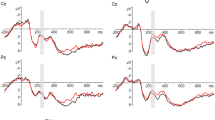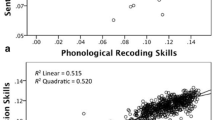Abstract
Previous studies [Scott & Ehri (1990) Journal of Reading Behavior22: 149–166; de Abreu & Cardoso-Martins (1998) Reading and Writing:An Interdisciplinary Journal 10: 85–104] have shown thatprereaders who know the names of the lettersuse a visual–phonological strategy to learn toread words in which the names of one or moreletters can be clearly detected in thepronunciation of the words. The present resultsextend these findings by showing that BrazilianPortuguese-speaking prereaders who know thenames of the letters can process letter–soundrelations to learn to read spellings in whichthe letters correspond to phonemes, not toletter names. Following Ehri & Wilce'sprocedure [(1985) Reading Research Quarterly 20:163–179], Brazilian preschool childrenlearned to read two types of simplifiedspellings: phonetic spellings, that is,spellings in which the letters corresponded tophonemes in the pronunciation of the words(e.g., SPT for sapato), and visualspellings, that is, spellings in which theletters did not correspond to sounds in thepronunciation of the words, but which werevisually more salient (e.g., VST for pijama). The children learned to read thephonetic spellings more easily than the visualspellings, suggesting that they recognized theletter–phoneme relations in learning to readthe phonetic spellings. This interpretation isbolstered by the results of correlationalanalyses between knowledge of letter sounds andperformance on the two word-learning tasks.While knowledge of letter–phonemecorrespondences did not correlate withperformance on the word-learning task with thevisual spellings, it correlated significantlyand positively with the children's ability tolearn to read the phonetic spellings.
Similar content being viewed by others
References
Blatchford, P. & Plewis, I. (1990). Pre-school reading related skills and later reading achievement: Further evidence, British Journal of Educational Psychology 16: 425-428.
Blatchford, P., Burke, J., Farquhar C., Plewis, I. & Tizard, B. (1987). Associations between pre-school reading related skills and later reading achievement, British Journal of Educational Psychology 13: 15-23.
Bowey, J. (1994). Phonological sensitivity in novice readers and nonreaders, Journal of Experimental Child Psychology 58: 134-159.
Bradley, L. & Bryant, P. (1991). Phonological skills before and after learning to read. In: S. Brady & D. Shankweiler (eds.), Phonological processes in literacy: A tribute to Isabelle Y. Liberman (pp. 37-46). Hillsdale, New Jersey: Lawrence Erlbaum Associates.
Byrne, B. (1992). Studies in the acquisition procedure for reading: Rationale, hypotheses, and data. In: P. Gough, L. Ehri & R. Treiman (eds.), Reading acquisition (pp. 1-34). Hillsdale, New Jersey: Lawrence Erlbaum Associates.
Cardoso-Martins, C. (1995). Sensitivity to rhymes, syllables, and phonemes in literacy acquisition in Portuguese, Reading Research Quarterly 30: 808-828.
Chall, J.S. (1967). Learning to read: The great debate. New York: McGraw-Hill.
Chomsky, C. (1979). Approaching reading through invented spelling. In: L.B. Resnick & P.A. Weaver (eds.), Theory and practice of early reading, Vol 2 (pp. 43-65). Hillsdale, New Jersey: Lawrence Erlbaum Associates.
de Abreu, M. & Cardoso-Martins, C. (1998). Alphabetic access route in beginning reading acquisition in Portuguese: The role of letter-name knowledge, Reading and Writing: An Interdisciplinary Journal 10: 85-104.
Ehri, L. (1983). A critique of five studies related to letter-name knowledge and learning to read. In: L. Gentile, M. Kamil & J.S. Blanchard (eds.), Reading research revisited (pp. 143-153). Columbus, Ohio: Merrill.
Ehri, L. (1986). Sources of difficulty in learning to spell and read. In: M. Wolraich & D. Routh (eds.), Advances in developmental and behavioral pediatrics (pp. 121-195). Greenwich: Jai Press.
Ehri L. (1992). Reconceptualizing the development of sight word reading and its relationship to recoding. In: P. Gough, L. Ehri & R. Treiman (eds.), Reading acquisition (pp. 107-143). Hillsdale, New Jersey: Lawrence Erlbaum Associates.
Ehri, L. & Wilce, L. (1985). Movement into reading: Is the first stage of printed word learning visual or phonetic?, Reading Research Quaterly 20: 163-179.
Frith, U. (1985). Beneath the surface of developmental dyslexia. In: K. Patterson, J. Marshall & M. Coltheart (eds.), Surface dyslexia: Neuropsychological and cognitive studies of phonological reading (pp. 301-330). Hillsdale, New Jersey: Lawrence Erlbaum Associates.
Goswami, U. & Bryant, P. (1990). Phonological skills and learning to read. Hillsdale, New Jersey: Lawrence Erlbaum Associates.
Gough, P. & Hillinger, M. (1980). Learning to read: An unnatural act, Bulletin of the Orton Society 30: 179-196.
Gough, P., Juel, C. & Griffith, P. (1992). Reading, spelling and the orthographic cipher. In: P. Gough, L. Ehri & R. Treiman (eds.), Reading acquisition (pp. 35-48). Hillsdale, New Jersey: Lawrence Erlbaum Associates.
Marsh, G., Friedman, M., Welch, V. & Desberg, P. (1981). A cognitive-developmental theory of reading acquisition. In: G. Mackinnon & T. Waller (eds.), Reading research: Advances in theory and practice (pp. 199-221). San Diego, California: Academic Press.
Mason, J. (1980). When do children begin to read: An exploration of four-year-old children's letter and word reading competencies, Reading Research Quarterly 15: 203-227.
Masonheimer, P., Drum, P. & Ehri, L. (1984). Does environmental print identification lead children into word reading?, Journal of Reading Behavior 16: 257-271.
Murray, B. (1998). Gaining alphabetic insight: Is phoneme manipulation skill or identity knowledge causal?, Journal of Educational Psychology 90: 461-475.
Pinheiro, A. (1996). Contagem de frequê ncia de ocorrê ncia de palavras expostas a crianç as na faixa pré-escolar e séries iniciais do 1? grau [A word frequency count for children in elementary school]. Sã o Paulo: Associaç ã o Brasileira de Dislexia.
Pinheiro, A. & Keys, K. (1987). A word frequency count in Brazilian Portuguese. Unpublished manuscript, University of Dundee, Dundee.
Rack, J., Hulme, C., Snowling, M. & Wightman, J. (1994). The role of phonology in young children learning to read words: The direct-mapping hypothesis, Journal of Experimental Child Psychology 57: 42-71.
Read, C. (1971). Preschool children's knowledge of English phonology, Harvard Educational Review 41: 1-34.
Scott, J. & Ehri, L. (1990). Sight word reading in prereaders: Use of logographic vs. alphabetic access routes, Journal of Reading Behavior 22: 149-166.
Seymour, P. (1986). Cognitive analysis of dyslexia. New York: Routledge & Kegan Paul.
Stuart, M., Coltheart, M. (1988). Does reading develop in a series of stages?, Cognition 30: 139-181.
Treiman, R. & Broderick, V. (1998). What's in a name: Children's knowledge about the letters in their own names, Journal of Experimental Child Psychology 70: 97-116.
Treiman, R., Tincoff, R. & Richmond-Welty, E. D. (1996). Letter names help children to connect print and speech, Developmental Psychology 32: 505-514.
Treiman R., Weatherston, S. & Berch, D. (1994). The role of letter names in children's learning of phoneme-grapheme relations, Applied Psycholinguistics 15: 97-122.
Wimmer, H. & Hummer, P. (1990). How German-speaking first graders read and spell: Doubts on the importance of the logographic stage, Applied Psycholinguistics 11: 349-368.
Author information
Authors and Affiliations
Corresponding author
Rights and permissions
About this article
Cite this article
Cardoso-Martins, C., Resende, S.M. & Rodrigues, L.A. Letter name knowledge and the ability to learn to read by processing letter–phoneme relations in words: Evidence from Brazilian Portuguese-speaking children. Reading and Writing 15, 409–432 (2002). https://doi.org/10.1023/A:1015213514722
Issue Date:
DOI: https://doi.org/10.1023/A:1015213514722




